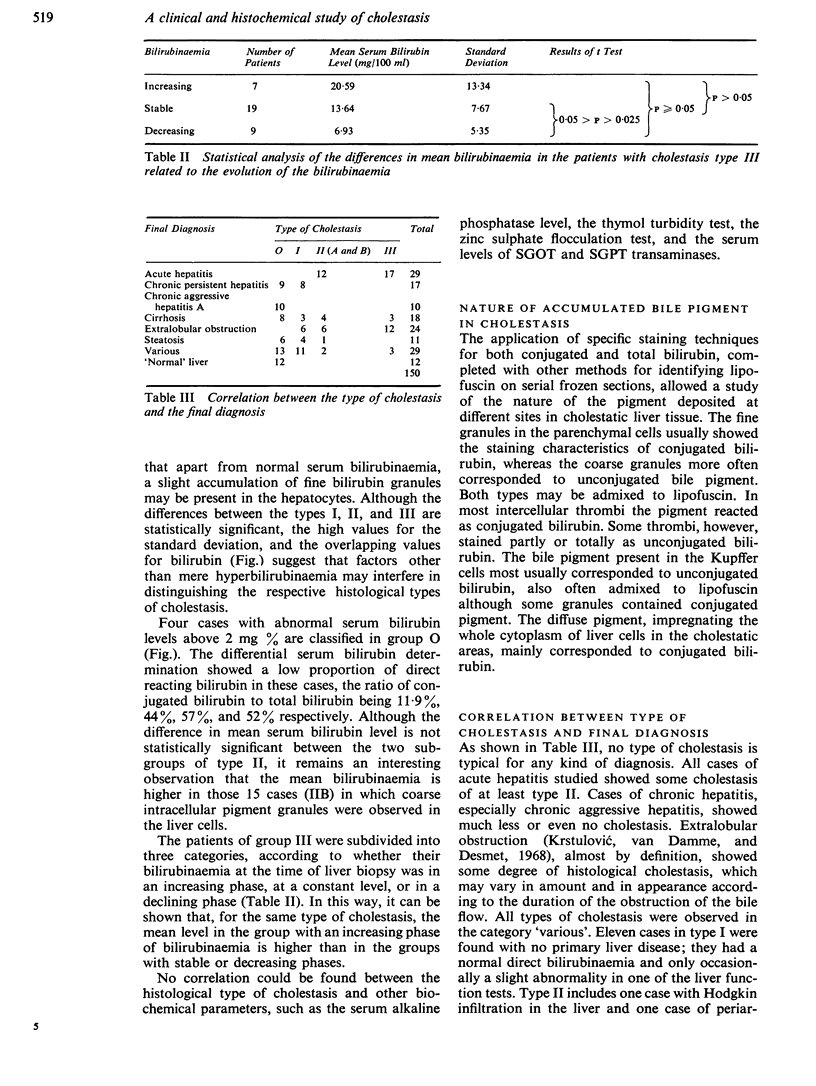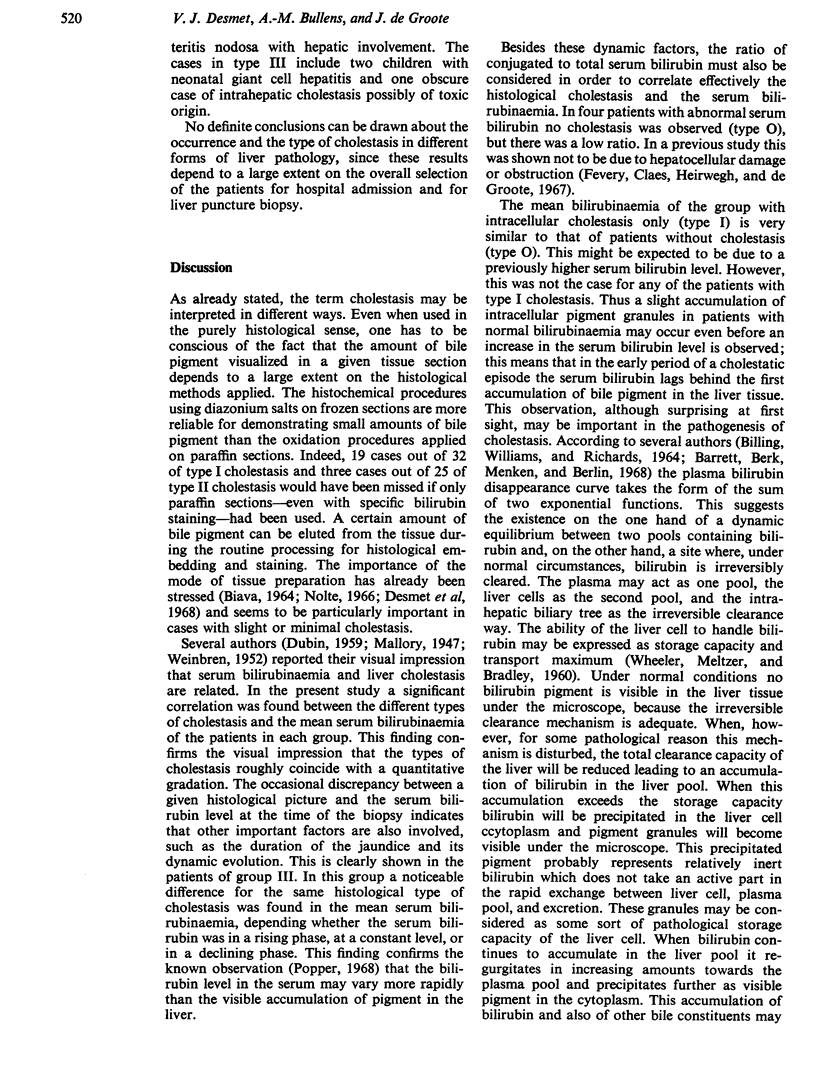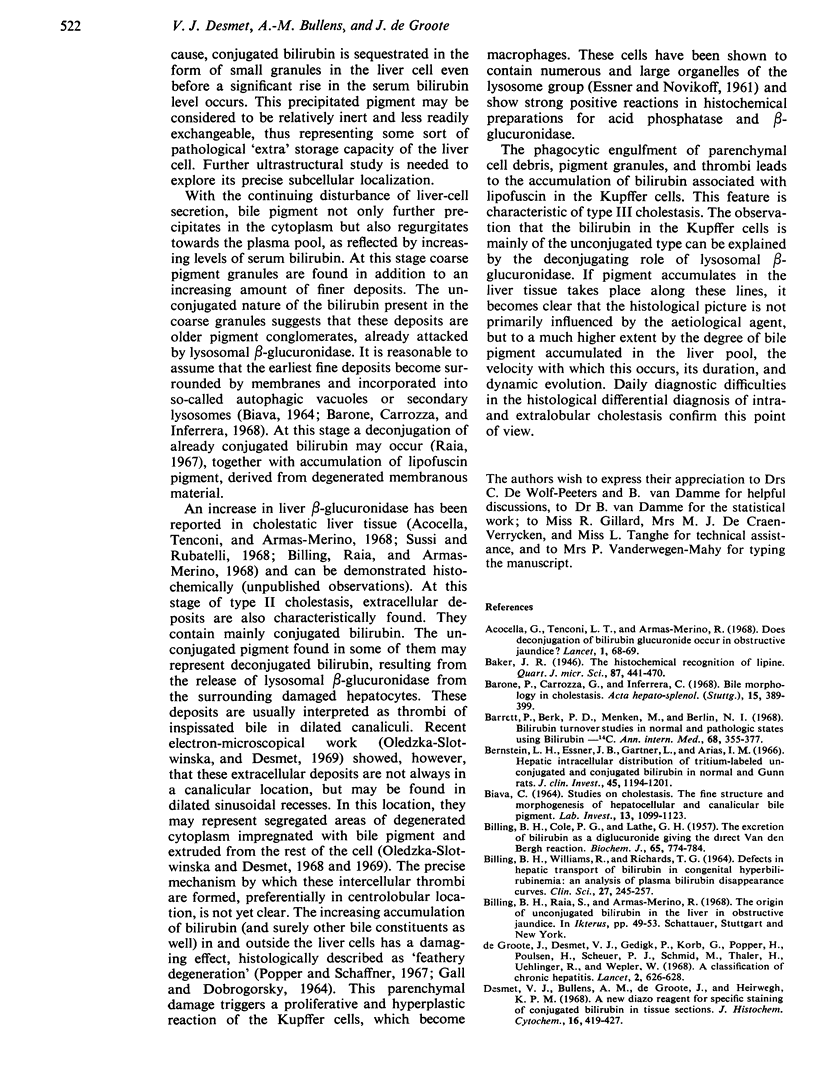Abstract
A histochemical study of conjugated and total bilirubin was made on liver biopsies of 150 patients. Three types of cholestasis were defined: type I, characterized by the presence of intracellular pigment granules in the hepatocytes; type II, showing intracellular granules and extracellular thrombi (this group may be subdivided according to the eventual presence of coarse pigment deposits in the parenchymal cells); and type III, showing intracellular granules, extracellular thrombi, and also bile pigment in the Kupffer cells. The fine liver cell granules correspond mainly to conjugated bilirubin, whereas the coarse deposits usually contain unconjugated pigment. The extracellular thrombi mostly contain conjugated bilirubin; the Kupffer cell pigment is predominantly of the unconjugated type. In cholestasis types II and III a diffuse directly reacting pigment is also observed. The finding of unconjugated pigment in different locations and the eventual deconjugation by β-glucuronidase is discussed. A correlation was found between the different types of cholestasis, the level of bilirubinaemia, and its dynamic evolution. This suggests that the proposed types of cholestasis may represent successive stages of increasing cholestasis. The type of cholestasis and the nature of the pigment are largely independent of the aetiology.
It is shown that a large percentage of minor degrees of cholestasis is missed when only conventional histological methods are used.
The mechanisms by which morphological cholestasis is brought about are discussed in the light of the present findings.
Full text
PDF







Selected References
These references are in PubMed. This may not be the complete list of references from this article.
- Acocella G., Tenconi L. T., Armas-Merino R., Raia S., Billing B. H. Does deconjugation of bilirubin glucuronide occur in obstructive jaundice? Lancet. 1968 Jan 13;1(7533):68–69. doi: 10.1016/s0140-6736(68)90069-x. [DOI] [PubMed] [Google Scholar]
- BIAVA C. STUDIES ON CHOLESTASIS. THE FINE STRUCTURE AND MORPHOGENESIS OF HEPATOCELLULAR AND CANALICULAR BILE PIGMENT. Lab Invest. 1964 Sep;13:1099–1123. [PubMed] [Google Scholar]
- BILLING B. H., COLE P. G., LATHE G. H. The excretion of bilirubin as a diglucuronide giving the direct van den Bergh reaction. Biochem J. 1957 Apr;65(4):774–784. doi: 10.1042/bj0650774. [DOI] [PMC free article] [PubMed] [Google Scholar]
- BILLING B. H., WILLIAMS R., RICHARDS T. G. DEFECTS IN HEPATIC TRANSPORT OF BILIRUBIN IN CONGENITAL HYPERBILIRUBINAEMIA: AN ANALYSIS OF PLASMA BILIRUBIN DISAPPEARANCE CURVES. Clin Sci. 1964 Oct;27:245–257. [PubMed] [Google Scholar]
- Barone P., Carrozza G., Inferrera C. Bile morphology in cholostasis. Acta Hepatosplenol. 1968 Nov-Dec;15(6):389–399. [PubMed] [Google Scholar]
- Barrett V., Berk P. D., Menken M., Berlin N. I. Bilirubin turnover studies in normal and pathologic states using bilirubin-14C. Ann Intern Med. 1968 Feb;68(2):355–377. doi: 10.7326/0003-4819-68-2-355. [DOI] [PubMed] [Google Scholar]
- Bernstein L. H., Ezzer J. B., Gartner L., Arias I. M. Hepatic intracellular distribution of tritium-labeled unconjugated and conjugated bilirubin in normal and Gunn rats. J Clin Invest. 1966 Jul;45(7):1194–1201. doi: 10.1172/JCI105425. [DOI] [PMC free article] [PubMed] [Google Scholar]
- DUBIN I. N. Intraphepatic bile stasis in acute nonfatal viral hepatitis; its incidence, pathogenesis, and correlation with jaundice. Gastroenterology. 1959 May;36(5):645–660. [PubMed] [Google Scholar]
- De Groote J., Desmet V. J., Gedigk P., Korb G., Popper H., Poulsen H., Scheuer P. J., Schmid M., Thaler H., Uehlinger E. A classification of chronic hepatitis. Lancet. 1968 Sep 14;2(7568):626–628. doi: 10.1016/s0140-6736(68)90710-1. [DOI] [PubMed] [Google Scholar]
- Desmet V. J., Bullens A. M., De Groote J., Heirwegh K. P. New diazo reagent for specific staining of conjugated bilirubin in tissue sections. J Histochem Cytochem. 1968 Jun;16(6):419–427. doi: 10.1177/16.6.419. [DOI] [PubMed] [Google Scholar]
- ESSNER E., NOVIKOFF A. B. Human hepatocellular pigments and lysosomes. J Ultrastruct Res. 1960 Jun;3:374–391. doi: 10.1016/s0022-5320(60)90016-2. [DOI] [PubMed] [Google Scholar]
- ESSNER E., NOVIKOFF A. B. Localization of acid phosphatase activity in hepatic lysosomes by means of electron microscopy. J Biophys Biochem Cytol. 1961 Apr;9:773–784. doi: 10.1083/jcb.9.4.773. [DOI] [PMC free article] [PubMed] [Google Scholar]
- Fevery J., Claes J., Heirwegh K., De Groote J. Hyperbilirubinemia: significance of the ratio between direct-reacting and total bilirubin. Clin Chim Acta. 1967 Jul;17(1):73–79. doi: 10.1016/0009-8981(67)90098-8. [DOI] [PubMed] [Google Scholar]
- GALL E. A., DOBROGORSKI O. HEPATIC ALTERATIONS IN OBSTRUCTIVE JAUNDICE. Am J Clin Pathol. 1964 Feb;41:126–139. doi: 10.1093/ajcp/41.2.126. [DOI] [PubMed] [Google Scholar]
- HALL M. J. A staining reaction for bilirubin in sections of tissue. Am J Clin Pathol. 1960 Oct;34:313–316. doi: 10.1093/ajcp/34.4.313. [DOI] [PubMed] [Google Scholar]
- HEIRWEGH K., VANROY F., DEGROOTE J. DISTRIBUTION OF BILIRUBIN AND BILIRUBIN GLUCURONIDE OVER CELL FRACTIONS. Tijdschr Gastroenterol. 1964;7:184–187. [PubMed] [Google Scholar]
- Krstulović B., Van Damme, Desmet V. J. Comparative histochemical study of rat liver in bile-duct ligation and in alpha-napthyl isothiocyanate (ANIT) intoxication. Am J Pathol. 1968 Feb;52(2):423–436. [PMC free article] [PubMed] [Google Scholar]
- METGE W. R., OWEN C. A., Jr, FOULK W. T., HOFFMANN H. N., 2nd BILIRUBIN GLUCURONYL TRANSFERASE ACTIVITY IN LIVER DISEASE. J Lab Clin Med. 1964 Jul;64:89–98. [PubMed] [Google Scholar]
- Nolte D. Ikterus der Leber bei chronischer Herzinsuffizienz. Virchows Arch Pathol Anat Physiol Klin Med. 1966 Apr 13;341(1):37–42. [PubMed] [Google Scholar]
- ORLANDI F. Electron-microscopic observations on human liver during cholestasis. Acta Hepatosplenol. 1962 May-Jun;9:155–164. [PubMed] [Google Scholar]
- Oledzka-Slotwinska H., Desmet V. Participation of the cell membrane in the formation of "autophagic vacuoles". Virchows Arch B Cell Pathol. 1969;2(1):47–61. [PubMed] [Google Scholar]
- Popper H. Cholestasis. Annu Rev Med. 1968;19:39–56. doi: 10.1146/annurev.me.19.020168.000351. [DOI] [PubMed] [Google Scholar]
- Sussi P. L., Rubaltelli F. F. Beta-glucuronidase activity in cholestatic liver. Lancet. 1968 Dec 28;2(7583):1396–1397. doi: 10.1016/s0140-6736(68)92708-6. [DOI] [PubMed] [Google Scholar]
- Van Roy F. P., Heirwegh K. P. Determination of bilirubin glucuronide and assay of glucuronyltransferase with bilirubin as acceptor. Biochem J. 1968 Apr;107(4):507–518. doi: 10.1042/bj1070507. [DOI] [PMC free article] [PubMed] [Google Scholar]
- WEINBREN K. The pathology of hepatitis. J Pathol Bacteriol. 1952 Apr;64(2):395–413. doi: 10.1002/path.1700640215. [DOI] [PubMed] [Google Scholar]
- WHEELER H. O., MELTZER J. I., BRADLEY S. E. Biliary transport and hepatic storage of sulfobromophthalein sodium in the unanesthetized dog, in normal man, and in patients with hepatic disease. J Clin Invest. 1960 Jul;39:1131–1144. doi: 10.1172/JCI104128. [DOI] [PMC free article] [PubMed] [Google Scholar]


